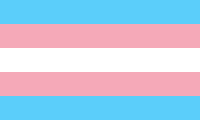
Photo from wikipedia
A growing number of adolescents are seeking medical care to alleviate gender dysphoria (GD). This qualitative study explored the subjective experiences of GD among help-seeking transgender and gender nonconforming (TGNC)… Click to show full abstract
A growing number of adolescents are seeking medical care to alleviate gender dysphoria (GD). This qualitative study explored the subjective experiences of GD among help-seeking transgender and gender nonconforming (TGNC) youth in order to develop a more nuanced conceptualization of the phenomenon. Fifteen life-mode interviews were conducted with newly referred youth between the ages of 13 and 19. All participants were assigned female at birth. The data were analyzed using thematic analysis. The participants targeted five major themes that characterize GD: (1) Bodily sensations were constant reminders of GD throughout the day, (2) emotional memories from the past of being different and outside triggered GD, (3) the process of coming out was a transformative experience that changed how the participants understood themselves, (4) GD both increased and decreased in relation to others, (5) everyday life required careful negotiation to feel whole without developing new forms of GD. Based on the results, we suggest a more conceptually nuanced model of GD, one which accounts for how bodily sensations and emotional memories from the past were sources that elicited GD. The sources were mediated through the process of coming out and relating to others, and this resulted in the negotiation of GD today. The conceptual model suggested in the present study could ideally shed light on preexisting knowledge on TGNC youth struggling with GD. In addition, an improved understanding of GD could ideally help clinicians when addressing individual treatment needs.
Journal Title: Archives of sexual behavior
Year Published: 2021
Link to full text (if available)
Share on Social Media: Sign Up to like & get
recommendations!